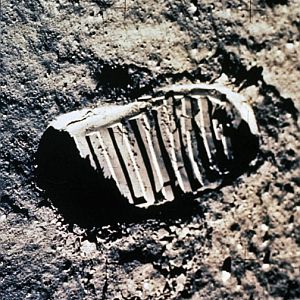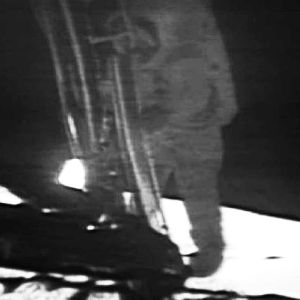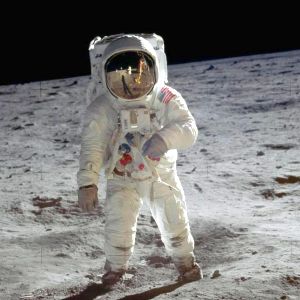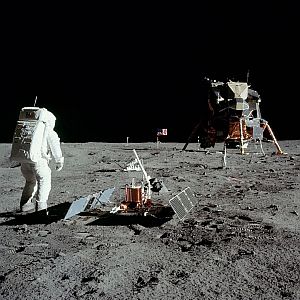
Für eine deutsche Übersetzung dieser Seite einfach die Brandenburger Flagge anklicken
 |
Click the Brandenburg Flag for a German translation Für eine deutsche Übersetzung dieser Seite einfach die Brandenburger Flagge anklicken |


|
|
MoonA collection of pictures of the Lunar surface,
|
|


 |
Buzz Adrin's bootprint on the Lunar surface is one of the most iconic images of the entire space program. (Source: NASA) Between 1969 and 1972 six US American crews landed sucessfully on the moon. They not only returned 842 pounds (382 kg) of lunar rocks, but also hundreds of high resolution pictures. Like our other space galleries, our favorite pictures have not been selected because of their scientific significance but because of their esthetic value and sometimes because of their historical importance. |


|
On July 20, 1969, at 20:17:40 UTC, the Eagle, the Lunar Module of the
Apollo 11 spacecraft landed on in the Lunar
Sea of Tranquility and on Monday July 21, 1969 at 02:56:15 UTC,
the first human set foot on the moon. Neil Armstrong's descends on the Eagle's ladder was recorded by a TV camera mounted at the Eagle. These grainy pictures were the first images of a human walking on another world. After the safe return of the Apollo 11 crew, the world got to see the first high definition color images. Since only Neil Armstrong carried a camera, we can only see fellow astronaut Buzz Aldrin on the Lunar surface. The only pictures of Neil Armstrong are those taken by the Eagle's camera and reflections in Buzz Aldrin's visor. |

|

  Neil Armstrong at the surface, taken by the LEM camera; Source: Wikipedia |
  Buzz Aldrin decending the LEM ladder Source: magnoliabox.com |
  Buzz saluting the flag Source: Wikipedia |

  Buzz Aldrin next to the LEM Source: scienceblogs.de |
  Buzz Aldrin walking on the Moon Source: University of Maryland |
  Buzz Aldrin next to the Passive Seismic Experiment Source: Wikipedia |


|
Each of the following missions covered more terrain than the previous one. On November 19, 1969,
Apollo 12 conducted a precision landing in the
Ocean of Storms right next to the unmanned probe
Surveyor 3, which had landed there in 1967. The crew spent over 24 hours on the lunar surface and returned pieces of Surveyor 3. Apollo 14, which landed on February 5, 1971 in the Fra Mauro Highlands extended the stay on the surface to 36 hours. |

  Apollo 12 LEM Pilot Alan Bean on the Lunar surface Source: Smithsonian Natl. Air and Space Museum |
  Charles Conrad next to Surveyor 3 with the Apollo 12 LEM in the background; Source: Wikipedia |
  Apollo 14 Commander Alan Shepard saluting the flag Source: Wikipedia |

 |

|
|
Apollo 15 LEM pilot Steve Irwin with the LEM and the LRV Source: Wikipedia |
Steve Irwin with the LRV Source: Wikipedia |

|
The last three missions each spent several days on the Moon, using the Lunar Roving Vehicle
to cover more terrain. Apollo 15 landed on July 30, 1971 near the Hadley–Apennine Ridge. In three days, the crew traveled 17.3 miles in the LRV. Apollo 16 landed in the Descartes Highlands on April 21, 1972. The crew spent 71 hours on the Lunar surface. During three EVAs, the drove the Lunar Rover for 16.6 miles (26.7 km). The crew of Apollo 17, the - so far - last humans on the Moon, Eugene Cernan and Harrison Schmitt, landed in the Taurus–Littrow Valley on December 11, 1972. They stayed for three days and logged 22.21 miles (35.74 km) with the rover.
XXXX Picture right shows the final resting place of the Apollo 15 rover on the moon. Source: Wikipedia |

|

  Apollo 16 Commander John Young at the LRV Source: Smithsonian Natl. Air and Space Museum |
  John Young saluting the flag Source: Wikipedia |
  Apollo 16 LEM Pilot Charles Duke at the LRV Source: Smithsonian Natl. Air and Space Museum |

  Apollo 17 Commander Eugene Cernan riding the LRV Source: Wikipedia |
  Eugene Cernan on the Lunar surface Source: Wikipedia |
  Apollo 17 scientist H. Schmitt collecting samples Source: Smithsonian Natl. Air and Space Museum |


|
|
Click here to return to the unmanned missions | Click here to move on to Mars |
|

|
Back to Solar System Page |
Back to Space Page |
Back to English Main Page |
 Back to Start Page |